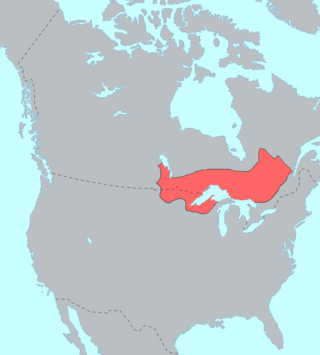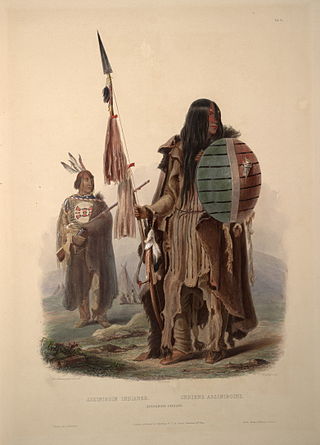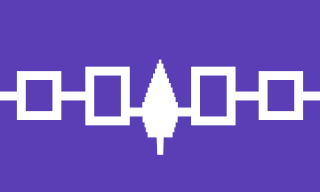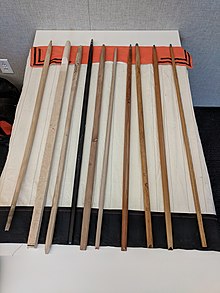
Snowshoes are specialized outdoor gear for walking over snow. Their large footprint spreads the user's weight out and allows them to travel largely on top of rather than through snow. Adjustable bindings attach them to appropriate winter footwear.

Hiawatha, also known as Ayenwathaaa or Aiionwatha, was a precolonial Native American leader and co-founder of the Iroquois Confederacy. He was a leader of the Onondaga people, the Mohawk people, or both. According to some accounts, he was born an Onondaga but adopted into the Mohawks.

The Ojibwe, Ojibwa, Chippewa, or Saulteaux are an Anishinaabe people in what is currently southern Canada, the northern Midwestern United States, and Northern Plains.

The Algonquin people are an Indigenous people who now live in Eastern Canada. They speak the Algonquin language, which is part of the Algonquian language family. Culturally and linguistically, they are closely related to the Odawa, Potawatomi, Ojibwe, Mississauga and Nipissing, with whom they form the larger Anicinàpe (Anishinaabeg). Algonquins call themselves Omàmiwinini or the more generalised name of Anicinàpe.
The Seneca are a group of Indigenous Iroquoian-speaking people who historically lived south of Lake Ontario, one of the five Great Lakes in North America. Their nation was the farthest to the west within the Six Nations or Iroquois League (Haudenosaunee) in New York before the American Revolution.

The Onondaga people are one of the original five constituent nations of the Iroquois (Haudenosaunee) Confederacy in northeast North America. Their traditional homeland is in and around present-day Onondaga County, New York, south of Lake Ontario. They are known as Gana’dagwëni:io’geh to the other Iroquois tribes. Being centrally located, they are considered the "Keepers of the Fire" in the figurative longhouse that shelters the Five Nations. The Cayuga and Seneca have territory to their west and the Oneida and Mohawk to their east. For this reason, the League of the Iroquois historically met at the Iroquois government's capital at Onondaga, as the traditional chiefs do today.

An Indian reservation is an area of land held and governed by a federally recognized Native American tribal nation whose government is accountable to the United States Bureau of Indian Affairs and not to the state government in which it is located. Some of the country's 574 federally recognized tribes govern more than one of the 326 Indian reservations in the United States, while some share reservations, and others have no reservation at all. Historical piecemeal land allocations under the Dawes Act facilitated sales to non–Native Americans, resulting in some reservations becoming severely fragmented, with pieces of tribal and privately held land being treated as separate enclaves. This jumble of private and public real estate creates significant administrative, political and legal difficulties.

The economy of the Haudenosaunee historically was based on communal production and combined elements of both horticulture and hunter-gatherer systems. Some have described the Iroquois economy as primitive communism. The tribes of the Iroquois Confederacy and other Northern Huron had their traditional territory in what is now New York State and the southern areas bordering the Great Lakes. The confederacy was originally composed of five tribes; the Mohawk, Onondaga, Oneida, Cayuga, and Seneca, who had created an alliance long before European contact. The Tuscarora were added as a sixth nation in the early eighteenth century after they migrated from North Carolina. The Huron peoples, located mostly in what is now Canada, were also Iroquoian-speaking and shared some culture, but were never part of the Iroquois.

The Assiniboine or Assiniboin people, also known as the Hohe and known by the endonym Nakota, are a First Nations/Native American people originally from the Northern Great Plains of North America.

Longhouses were a style of residential dwelling built by Native American First Nation peoples in various parts of North America. Sometimes separate longhouses were built for community meetings.

Lacrosse has its origins in a tribal game played by eastern Woodlands Native Americans and by some Plains Indians tribes in what is now the United States of America and Canada. The game was extensively modified by European settlers to create its current collegiate and professional form. There were hundreds of native men playing a ball game with sticks. The game began with the ball being tossed into the air and the two sides rushing to catch it. Because of the large number of players involved, these games generally tended to involve a huge mob of players swarming the ball and slowly moving across the field. Passing the ball was thought of as a trick, and it was seen as cowardly to dodge an opponent. Years later lacrosse is still a popular sport played all over the world.

Ganondagan State Historic Site, also known as Boughton Hill, is a Native American historic site in Ontario County, New York in the United States. Location of the largest Seneca village of the 17th century, the site is in the present-day Town of Victor, southwest of the Village of Victor. The village was also referred to in various spellings as Gannagaro, Canagora, Gandagora, Gandagaro and Gannontaa.

The Oneida Indian Nation (OIN) or Oneida Nation is a federally recognized tribe of Oneida people in the United States. The tribe is headquartered in Verona, New York, where the tribe originated and held its historic territory long before European colonialism. It is an Iroquoian-speaking people, and one of the Five Nations of the Iroquois Confederacy, or Haudenosaunee. Three other federally recognized Oneida tribes operate in locations where they migrated or were removed to during and after the American Revolutionary War: one in Wisconsin in the United States, and two in Ontario, Canada.

The Oglala are one of the seven subtribes of the Lakota people who, along with the Dakota, make up the Očhéthi Šakówiŋ. A majority of the Oglala live on the Pine Ridge Indian Reservation in South Dakota, the eighth-largest Native American reservation in the United States.

The Iroquois, officially the Haudenosaunee, are an Iroquoian-speaking confederacy of First Nations peoples in northeast North America/Turtle Island. They were known during the colonial years to the French as the Iroquois League, and later as the Iroquois Confederacy. The English called them the Five Nations, comprising the Mohawk, Oneida, Onondaga, Cayuga, and Seneca. After 1722, the Iroquoian-speaking Tuscarora people from the southeast were accepted into the confederacy, which became known as the Six Nations.
The Harvard Project on American Indian Economic Development, also known as the Harvard Project, was founded in 1987 at Harvard Kennedy School at Harvard University. It administers tribal awards programs as well as provides support for students and conducting research. The Harvard Project aims to understand and foster the conditions under which sustained, self-determined social and economic development is achieved among American Indian nations through applied research and service.

Indigenous North American stickball is a team sport typically played on an open field where teams of players with two sticks each attempt to control and shoot a ball at the opposing team's goal. It shares similarities to the game of lacrosse. In Choctaw Stickball, "Opposing teams use handcrafted sticks or kabocca, and a woven leather ball, or towa. Each team tries to advance the ball down the field to the other team's goalpost using only their sticks, never touching or throwing the ball with their hands. Points are scored when a player hits the opposing team's goalpost with the ball."

Arctic sports or Inuit games (Iñupiaq: anaktaqtuat) refer to a number of sports disciplines popularly practiced in the Arctic, primarily by the indigenous peoples of the region, such as the Inuit. Arctic sports often refer to the sports of Yamal, Alaska, Greenland and parts of Canada, while sports of the First Nations are referred to as Dene games. Traditional Greenlandic sports are referred to as Kalaallit Pinnguaataat. Many of the sports and disciplines are largely athletic in nature, while others lean more towards martial arts or gymnastics.

Early Native American recreational activities consisted of diverse sporting events, card games, and other innovative forms of entertainment that tribes invented using natural resources and materials. Most of these games and sporting events were recorded by observations from the early 1700s. Common athletic contests held by early American tribes included games of stickball, chunkey, archery, darts, foot races, and canoeing. Card and dice games were commonly used as forms of entertainment among tribes such as the Iroquois and Lakota. Several contests and games invented by American indigenous groups contributed to modern-day sports and casino play. Several indigenous games were tribe-specific; one of the most common games played specifically by the Iroquoian was the Bowl Game, played using colored balls and sticks.

















